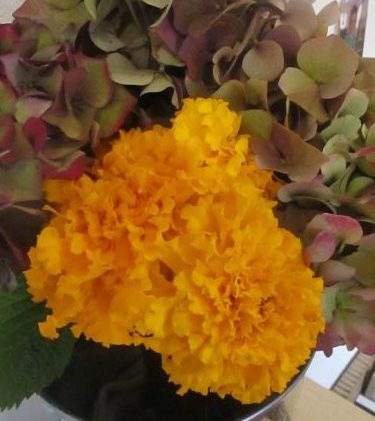
I’ve mention many times before in previous blog posts how nature is a great way for young children to learn many different skills. Hydrangeas are one of those hardy flowers that never let me down as far as all the wonderful texture and visual discoveries there are to observe. The leaves are dark to medium green, shiny, large, and the veins are very prominent which make for wonderful crayon rubbings and many more art infused projects.
The flower petals are clustered together and fit well and the violet color is so vibrant when they first bloom. This particular type of hydrangea has a second stage of flower color. Near the end of summer and into fall the flowers will change to a light green and dark red. So this plant just keeps giving us many more opportunities to observe how nature keeps changing in front of our eyes!

My second week bean sprouts are another great example of why nature is so useful for helping children form strong foundations for future learning. Once again we have color, shape, multiple leaves and prominent veins. The roots are not yet showing, but I’m sure they will in the next week of so. And being a vegetable, children will see how beans first form, what they end up looking like and why we enjoy them. Counting, color and shape recognition, texture from the soil, leaves and eventually the bean itself are just a small example of what children can learn from this plant and others. I mustn’t forget patterning too! 🙂

The mini marigolds are also wonderful examples of nature and the knowledge contained in each vegetative life. These flowers not only offer differing colors of petals, but the leaves are a wonderful lacy work to count, feel, pattern and admire. Being able to see the little buds form and then the flower bursting into something so lovely is also a good way to help young minds grasp the concept of change. Many young children struggle with change, in their home lives, at school and any other areas in their lives in which they interact with people and the environment. Change is an abstract concept somewhat and nature provides an easy concrete example. As adults we are always very much aware of how important routine with flexibility is and how crucial it is to pay close attention to the emotions young children experience as things change that are not in their control. I believe plants are a positive way to expose each to what change is and what it can mean.

I also wanted to mention that young minds will assimilate a large amount of new vocabulary as they grow and are exposed to the differing forms of nature. Modeling writing, writing their words for them, accepting what they give, and keeping growth charts and graphs of various sorts, will all support early literacy as children put on their science caps. Integrative curriculum strengthens the whole process of questioning, experimenting, discovering, constructing and working as a team. The summer season is here and I look forward to meeting new friends! So come join me in a continued learning journey at The Marigold School of Early Learning! 🙂
Heidi Scott, BA & MIT
